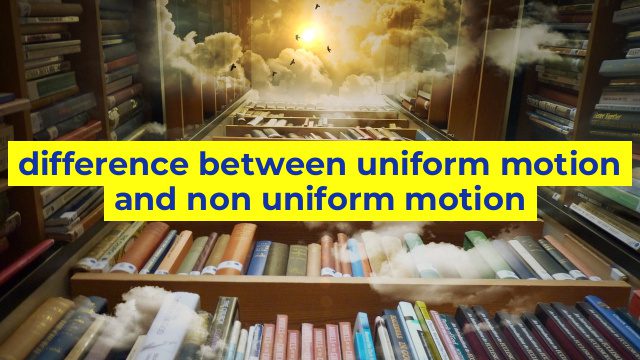Difference Between Uniform Motion and Non-Uniform Motion
Uniform Motion
Uniform motion can be defined as the motion of an object in which it covers equal distances in equal intervals of time. In other words, an object is said to be in uniform motion when it moves along a straight line with a constant speed. This means that the velocity of the object remains the same throughout its journey. Uniform motion is also known as rectilinear motion because the object is travelling in a straight line.
For example, if a car is travelling at a constant speed of 60 km/h on a straight road, it is in uniform motion. Here, the car covers 60 km of distance in one hour, and it will cover 120 km in two hours, 180 km in three hours, and so on.
Non-Uniform Motion
Non-uniform motion can be defined as the motion of an object in which it covers unequal distances in equal intervals of time. In other words, an object is said to be in non-uniform motion when there is a change in its speed or direction of motion. This means that the velocity of the object varies throughout its journey.
For example, if a car starts from rest, then picks up speed and travels at varying speeds on a curved road, it is in non-uniform motion. Here, the car covers more distance in a unit of time when it is moving faster and covers less distance when it is moving slower.
Their Differences
The main difference between uniform motion and non-uniform motion is that in uniform motion, the object moves with constant speed, whereas in non-uniform motion, the object moves with varying speeds. Another difference is that uniform motion occurs along a straight line, whereas non-uniform motion occurs along a curved path.
In uniform motion, the object covers equal distances in equal intervals of time, whereas in non-uniform motion, the object covers unequal distances in equal intervals of time. Additionally, in uniform motion, the velocity of the object remains constant, whereas in non-uniform motion, the velocity of the object changes.
In conclusion, it is important to understand the difference between uniform motion and non-uniform motion as it aids in understanding the movement of objects in different situations. These concepts are essential in physics and are widely used in fields such as engineering and mechanics.
Table difference between uniform motion and non uniform motion
Difference Between Uniform Motion and Non-Uniform Motion
| Uniform Motion | Non-Uniform Motion |
|---|---|
| When an object moves with a constant speed, it is said to be in uniform motion. | When an object moves at varying speeds, it is said to be in non-uniform motion. |
| Uniform motion occurs when there is no acceleration. | Non-uniform motion occurs when there is acceleration or deceleration. |
| In uniform motion, the distance traveled by an object in equal intervals of time is the same. | In non-uniform motion, the distance traveled by an object in equal intervals of time is not the same. |
| The velocity of an object in uniform motion is constant. | The velocity of an object in non-uniform motion is not constant. |
| The motion of an object in uniform motion can be represented by a straight line on a distance-time graph with a constant slope. | The motion of an object in non-uniform motion cannot be represented by a straight line on a distance-time graph. |
| Examples of uniform motion include a car traveling at a constant speed on a straight road or a satellite orbiting around the earth. | Examples of non-uniform motion include a car accelerating or decelerating, a ball thrown in the air or a roller coaster moving along a track. |

